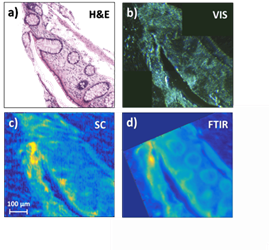Mid- And Near-IR Spectroscopy For Medical Diagnosis Project Develops New Range Of Diagnostic Tools

G&H would like to announce that the FP7 project MINERVA has now been completed. MINERVA (MId- to NEaR infrared spectroscopy for improVed medical diAgnostics) was funded by the European Commission through its Seventh Framework Programme (FP7). Co-ordinated by G&H, the project brought together thirteen partners from across Europe with the common objective of developing mid-infrared (mid-IR) technology based on supercontinuum sources (SCSs) to improve the early diagnosis of cancer.
The MINERVA system measures absorption peaks in the mid-IR range, allowing for analysis of a wide variety of biological constituents, such as fats, proteins, and DNA. This region of the spectrum offers exciting possibilities for real-time molecular-sensing, for example in medicine and healthcare (e.g. early cancer detection: the MINERVA application space), environment and energy (e.g. monitoring exhaust gases) and security (e.g. detection of narcotics or explosives; food security). In particular it has been shown that, through the latest data analysis techniques, this spectral region can be used to identify the presence of early cancer.
The demonstration referred to in the illustration sequence above showed that histological features can be resolved using a simplified MINERVA system. With the addition of IR cameras and acousto-optic tunable filters (AOTFs) the performance can be expected to increase significantly.
MINERVA has developed fiber, lasers and broadband sources, components, modulators and detectors to access this important part of the spectrum. In parallel it has identified analytical techniques using the new photonic hardware which in due course could help to improve early skin cancer diagnosis and the rapid automatic assessment of biopsy samples using a microscope.
These advances include:
- Chalcogenide fibers for infrared transmission and supercontinuum generation
- Ultra-low loss Pr-doped fiber for mid-IR fiber lasers
- First ever single-mode ZBLAN fused fiber coupler
- Various AOTFs for the wavelength range 1.5–4.5 µm
- Acousto-optic Q-switch suitable for 2.9 µm operation
- A novel multi-channel "smart driver" offering extremely flexible AOTF operation
- A new long-λ Ge based acousto-optic modulator suitable for operation beyond 10 µm
- Largest reported single crystal calomel crystals (35 mm diameter)
- Highest peak power 2.9 µm laser (10.6 kW)
- Longest wavelength ZBLAN supercontinuum source
- Record long wavelength average power (24 mW>4.5 μm) and long wavelength supercontinuum bandwidth (1.4–13.3 μm)
- Broadest mid-IR SCG in a tapered chalcogenide PCF spanning 1–11.5 μm
- Advances in T2SL mid-IR based sensors (detectors and readout ICs)
- First evaluation of multivariate algorithms with high spatial resolution FTIR
- Human skin equivalent standardised models
- Segmentation and registration algorithms for identification of structures in microscope images
- Algorithms for identification and differentiation of tumour cells from normal skin cells
- High resolution mid-IR imaging microscope based on SCS in the 3–4.5 µm wavelength range
- Scanning modality microscope based on SCS in the 4–7.5 µm wavelength range
In addition to these scientific achievements, MINERVA has driven the introduction of new products including lasers, SCSs, acousto-optic modulators and drivers, crystal and related components and detectors for the mid-IR.
See the website for more information, including a list of all the journal (almost forty) and conference papers (almost a hundred) published on the project results. This included a double dedicated session on MINERVA at Photonics West 2016, and a further session is planned for Photonics Europe 2018 (22–26 Apr-2018; Strasbourg, France). The project concluded with a workshop in Munich at which the project results were presented to a large audience of representatives from both industry and academia, and the slides are available from the website.
Project participants were:
- BBT Material Processing
- Gloucestershire Hospitals NHS Trust
- G&H – both (UK) and (Torquay) companies
- IRnova
- LISA Laser Products
- NKT Photonics
- Technical University of Denmark
- Universitat Politècnica de València
- University of Exeter
- University of Münster
- University of Nottingham
- Vivid Components
- Xenics
The public project report and final newsletter with further details of all these advances can be viewed here.
For further information please contact:
Jon Ward: jward@goochandhousego.com
Bruce Napier: bruce@vividcomponents.co.uk
About G&H
G&H is a photonics technology business headquartered in Ilminster, Somerset, UK with operations in the USA and Europe. A world leader in its field, the company researches, designs, engineers and manufactures advanced photonic systems, components and instrumentation for applications in the aerospace & defense, industrial systems, optical communications, life sciences and scientific research sectors. World leading design, development and manufacturing expertise is offered across a broad range of complementary technologies.
For further information on G&H's photonic technologies please contact info@goochandhousego.com or visit goochandhousego.com.
